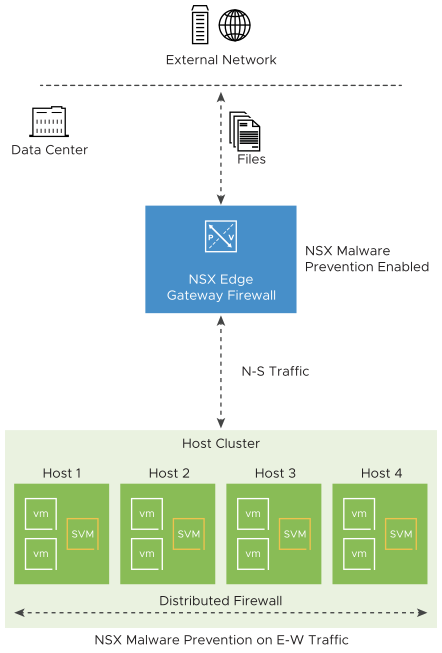The objective of NSX Intrusion Detection and Prevention Service (IDS/IPS) is to monitor network traffic on the hosts and edges for malicious activity by comparing the traffic against a known set of signatures. The objective of NSX Malware Prevention is to extract files from the network traffic on the hosts and edges and analyze these files for malicious behavior.
Overview of NSX Intrusion Detection and Prevention Service
NSX IDS/IPS monitors network traffic on a host for suspicious activity by comparing the traffic against signatures. A signature specifies a pattern for a type of network intrusion that needs to be detected and reported. Whenever a matching traffic pattern to a signature is found, a predefined action is taken, such as generating an alert or blocking the traffic from reaching its destination.
- Knowledge-based signatures: Knowledge-based signatures incorporate specific knowledge or pattern that corresponds to a known type of attack. In this approach, IDS attempts to detect intrusions based on already known malicious instruction sequences specified in signatures. Thus, knowledge-based signatures are limited to attacks that are already known and cannot cover targeted or zero-day threats.
- Behavior-based detection: Behaviour-based detection attempts to identify anomalous behavior by pinpointing interesting events that are different or unusual compared to a baseline or normal traffic.
These events are called informational or info and consists of events that pinpoint unusual activities in a network that are not necessarily malicious but can provide valuable information when investigating a breach. Signatures are bundled together with custom detection logic that can be updated without having to recompile or modify the IDS engine. Behavior-based detection introduces a new IDS intrusion severity level as 'suspicious'.
- Multi-tenancy
-
Starting with
NSX 4.1.1, multi-tenancy is also supported for
NSX IDS/IPS. With multi-tenancy, you can configure multiple tenants on a single
NSX deployment. Multi-tenancy enables isolation of security and networking configuration across tenants. The following conditions are applicable for
NSX IDS/IPS multi-tenancy:
- Signature management and NSX IDS/IPS settings are available only to the default project and not to custom projects.
- There is no configuration isolation between projects.
- Profiles and rules can be managed from both the default and custom projects.
- A rule created under default project will not have any tenancy context.
- A user can create rules under custom projects and this rule will have the tenancy context.
- An event triggered for a custom project will have the tenancy context.
- For custom projects, the NSX IDS/IPS monitoring dashboard will show events triggered for that project only.
Overview of NSX Malware Prevention
- Hash-based detection of known malicious files
- Local analysis of unknown files
- Cloud analysis of unknown files
The supported maximum file size limit for malware analysis is 64 MB.
- NSX Distributed Malware Prevention
-
Malware detection and prevention on the Distributed Firewall is supported for both Windows and Linux guest endpoints (VMs), which are running on vSphere host clusters that are prepared for NSX.
Local analysis and cloud analysis of all categories of malware files are supported. To view the list of supported file categories, see File Categories Supported for NSX Malware Prevention.
- NSX Malware Prevention on Gateway Firewall
-
Only detection of malware is supported on the Gateway Firewall. Local analysis and cloud analysis of all categories of malware files are supported. To view the list of supported file categories, see the hyperlinked topic that is mentioned in the NSX Distributed Malware Prevention section.

On the north-south traffic, the NSX Malware Prevention feature uses the IDS/IPS engine on the NSX Edges to extract or intercept the files that are entering the data center. On the east-west traffic, this feature uses the capabilities of the NSX Guest Introspection (GI) platform. If the file bypasses scrutiny on the NSX Edge and reaches the host, the file is extracted by the GI thin agent on guest VMs.
To detect and prevent malware on guest VMs, you must install the NSX Guest Introspection thin agent on guest VMs, and deploy the NSX Distributed Malware Prevention service on vSphere host clusters that are prepared for NSX. When this service is deployed, a service virtual machine (SVM) is installed on each host of the vSphere cluster and NSX Malware Prevention is enabled on the host cluster.
NSX Guest Introspection thin agent drivers for Windows are included with VMware Tools. To view the VMware Tools versions that are supported for your version of NSX, see the VMware Product Interoperability Matrix. To view the list of supported Windows guest operating systems for a specific VMware Tools version, see the release notes for that version in the VMware Tools documentation.
The Guest Introspection thin agent for Linux is available as part of the operating system specific packages (OSPs). The packages are hosted on VMware packages portal. Installing open-vm-tools or VM Tools is not required for Linux. To view the list of supported Linux guest operating system versions, see the Prerequisites section in Install the Guest Introspection Thin Agent for Anti-virus on Linux Virtual Machines.
- NSX Malware Prevention File Events
-
File events are generated when files are extracted by the IDS engine on the NSX Edges in the north-south traffic and by the NSX Guest Introspection agent on the virtual machine endpoints in the distributed east-west traffic.
NSX Malware Prevention feature inspects the extracted files to determine whether they are benign, malicious, or suspicious. Each unique inspection of a file is counted as a single file event in NSX. In other words, a file event refers to a unique file inspection.
For information about monitoring the NSX Malware Prevention file events by using the UI, see Monitoring File Events.
For information about monitoring the file events by using the NSX Malware Prevention file event APIs, see the documentation on the VMware Developer Documentation portal.